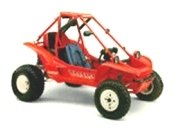I will do my best to answer your question. When altering the exhaust or any port in that matter there a lot to consider. The port map is a great starting point to do some calculations before altering anything. The map must (and I stress must) be used in conjunction with the
Engine parameters and components. I know that is not your question but please bare with me.
Also when looking at the marked up map its just a guess on the actual numbers as I was only working off a picture and scaling it to fit.
Short version: .95 bridge AROUND THE WALL verses across the port as measure with a caliper down the cylinder.
When you do a port map it tracks the wall and the ports in a diameter. Then when you remove the paper from the cylinder it can laid flat and and easier measured or transferred to graph paper for calculation. You also must maintain a certain value between the exhaust port and the main transfer port to reduce charge loss or short cycling. Future more its important to know the cranks position for angle area mean line to which the port is most effective. By this I mean do not widen it below the mean line as it will not aid but hinder the charge density. Never reduce the bridge area as it only make the bridge expand at a greater rate. If you look the line across the top of the transfers as it runs through the exhaust you can see the shortest distance between the ports. If you need more area and not time you can taper above this distance and taper back adding area. If you need time and area which most need then as you taper you also raise and increase bridge taper as well. Be darn sure you need time before you do it or you will have a time bomb on your hands. As you add time you increase the mean line in degree of stroke which reduces area if port width is left alone. You only do this if the angular area is to high for you (T).
You pipe plays a part in this as well If you to hot or too cold to short to long (LT), it will effect the charge density via the stufer charge upon EX port closure. Not only do we concern ourselves with the intake charge but the exhaust gases them selves If you add time the port opens sooner and the HOT gases start to flow sooner removing heat from the crown sooner. If you look a the burn rate example you will see combustion is done why before port opening so a few degrees will only help. That leads us to blow down or the degrees between EXO and TRO. If the EXO is sooner than the blow down is degree is greater. This is also an advantage for most engines. Again go to map and the time area. If you need more time area than you can raise them as well as long as you watch you main transfer to exhaust distance. Since were talking ody the shorter stroke and rod ratio must also be taken into account. This is why a head design for the ody is not a simple one size fits all with the pre and post cylinders/heads. As soon as over bore a 78.5 your time area is out of wack on the exhaust. Any port that has a taper to it shrinks with an increase in bore and since the angular area calculations are based on bore the port time area decreases. The other effect is (CR)compression ratio and (MSV) max squish velocity. You compression ratio calculation is based off of cylinder/head/gasket volume at EXO or your (TCR)trapped volume aka (CCR) corrected compression ration. You MSV is based off of the Engine and head numbers, bore area ratio of the head/squish angle/squish clearance/RPM/CCR/bore/rod lenght/EXO. If you over bore with no (T) change on the EX then you have an increase in both CCR and MSV, if you restore EX and CCR and leave bore area ratio alone you have an increase in MSV. If you raise the ex only then you you have a possablility of increase in the rpm which also increases MSV and reduction in angular area.
Break time.
motor ((
Internal Combustion Engine ? )) motor (( Internal Combustion Engine ? )) motor (( Internal Combustion Engine ? )). ok got your laugh in.
Now that we have most likly increased the CCR and MSV and a reduction in T and angular area the Engine has been retarded in port timing by way of over bore and yet we try to rev it higher, Oh no. The increase in MSV and CCR increases heat and the longer the greater heat is on the piston and reduce angular area greater chances of failure. When we look at the MSV we look at MS, MJ and the angle before TDC (Top Dead Center). To high in MS,to great in MJ and to soon in angle lead to preignition and detonation. By the way don't forget about the pipe. More heat speeds up the pipes tune for a given LT. That mean the return wave is getting back sooner but we restored the ex port not raised it, good or bad depends on (T) and angular area.
So now you see why not only area but time area is also important in the angular area calculation if you leave all above deck alone.






